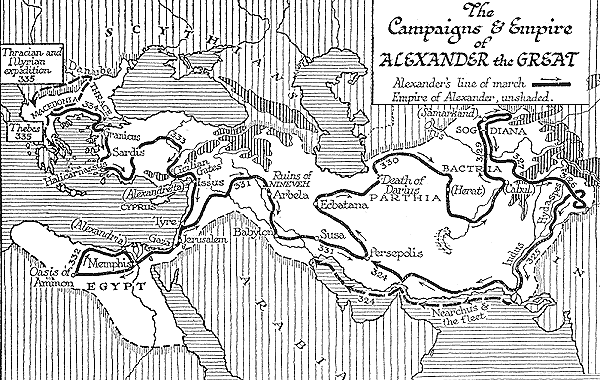|
Alexander ( The Helenistic Period) Including The Seleucids |
||
|
The conquest of Persia by Alexander's armies left the Persian army in complete disarray. Alexander captured Babylon, Susa and then Persepolis. The splendour of Persepolis was short lived, as the palaces were looted and burned by Alexander in just one night.
The Greeks were then in possession of the ancient world from Egypt to Indus, and from Oxus to the Danube. Alexander followed a policy of integration between the Greeks and the Persian communities, encouraging marriages and applying the formula of magnanimity and generosity, which had formerly brought success to Cyrus II.
In 324 B.C., having travelled down the Indus as far as its delta, he returned to Babylon where he fell ill and died in 323 B.C., at the age of 32, without having nominated an heir to his empire.
 |
Those who succeeded him, were the so-called Diadochi, who fought among themselves and after the battle of Ipsus (301 B.C.), Alexander's Empire was finally divided into three main segments. The Ptolemaic Dynasty ruling Egypt, the Macedonian monarchy ruling Europe and Seleucus I ruling the east including; Mesopotamia, Iran, Syria and Bactria.
(The Hellenistic period in Iran began in 331 B.C. and continued until c. 250 B.C.
This was the time when the Greeks tried to impose their culture on Asia. During approximately a century and a half of Greek rule in Iran, very little construction took place, and ruins from this period remain few and far between.)
The Seleucid capital was founded at "Antiochus" by Seleucus I. His son Antiochus, by an Iranian noblewoman, was put in charge of the eastern provinces.
The main difficulty that the Seleucid rulers faced was how to maintain the unity of an empire composed of a mosaic of different cultures and ethnic groups, and governed by independent-minded satraps. A new menace was added to this, that of the Parthians, a nomad people of Iranian origin who had settled in the region between the Caspian and Aral seas. In 250 B.C., Bactria proclaimed its independence, followed shortly afterwards by Parthia.
Antiochos III (223-187 B.C.) attempted to keep the empire together but in 189 B.C., the Roman army won a decisive victory against the Seleucids at the battle of Magnesia. Antiochos IV (175-164 B.C.) restored his position in western Iran, but failed to recoup Seleucid losses in the east.
The Seleucids tried on several occasions to force out the Parthians who had moved into northern Iran. However, the attempts of Demetrius I in 156 B.C., of Demetrius II in 141 to 140 B.C., and of Seleucus VII in 130 B.C. all failed.
| Persia or Iran | Top of page |
Persian Art Through the Centuries |
Copyright© 1998 K. Kianush, Art Arena